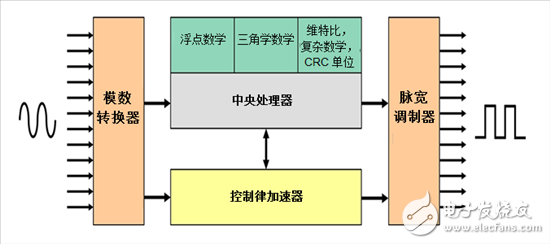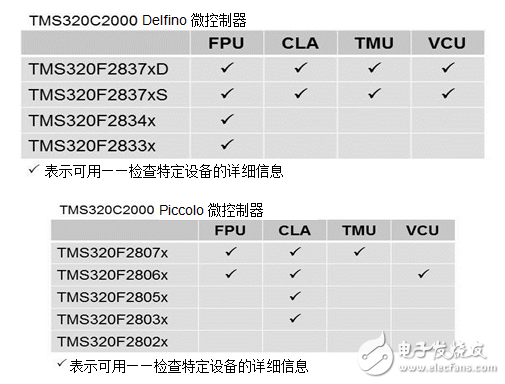Engineers designing real-time control systems continue to face the challenge of optimizing performance. These systems require minimal delay, where the time delay between sampling, processing, and output must be within a tight time window to meet performance specifications. At the heart of the control system is a mathematically intensive algorithm for calculating control signals. Microcontrollers (MCUs) that perform mathematical operations quickly and efficiently are key to achieving this goal. Ideally, the MCU will be able to execute real-time control loops while the central processing unit (CPU) is performing other required tasks. Some systems may even need to support power line communication (PLC) using the same MCU.

To this end, the TI C2000TM MCU integrates up to four integrated on-chip hardware accelerators to significantly improve device performance in many real-time applications. The four accelerators include a floating point unit (FPU), a real-time coprocessor control law accelerator (CLA), a trigonometric unit (TMU), and a Viterbi, complex math, CRC unit (VCU).
Each C2000 MCU is designed around a fast 32-bit fixed-point C28x CPU core that takes advantage of the best features of the digital signal processor and microcontroller architecture. Adding the FPU to the C28x fixed-point core (C28x + FPU) enables the device to seamlessly support hardware IEEE-754 single-precision floating-point format operations. Since floating-point math provides a large dynamic range compared to fixed-point math, developing code becomes easier, and the programmer no longer needs to care about scaling and saturation. Another advantage is that it improves robustness because values ​​do not wrap digital lines when overflowing or underflowing, as in fixed-point math. Use the compiler tools to easily write software and port existing code. The FPU instruction is an extension of the standard C28x instruction set, so most instructions will run in one or two pipeline cycles, and some instructions can be done in parallel. On average, using floating-point math can improve performance by more than 2.5 times compared to fixed-point math.
The CLA is a stand-alone 32-bit floating point hardware accelerator designed for mathematically intensive computing. It performs real-time control algorithms in parallel with the C28x CPU, effectively doubling the computing performance of the device. In general, CLA-enabled devices have improved performance by approximately 1.3 times compared to C28x CPUs when performing various control applications. In addition, by using CLA to troubleshoot time-critical functions, the C28x CPU can free up other tasks such as communication and diagnostics. Because the CLA has direct access to various control peripherals such as ADCs and PWM modules, it minimizes latency and has a fast trigger response. The CLA reads the ADC result register at the same cycle as the ADC sample conversion completes, providing an "instant" reading of the ADC, reducing sample-to-output delay, and allowing the system to respond more quickly to the frequency control loop. With the performance and efficiency benefits of CLA, complete complex real-time control applications can be implemented on a single device.
The TMU is an extension of the FPU that further enhances the C28x + FPU instruction set by efficiently performing the trigonometric and arithmetic operations commonly used in control system applications. Like the FPU, the TMU is an IEEE-754 floating-point accelerator that is tightly coupled to the C28x CPU, but with the FPU providing general-purpose floating-point math support, the TMU focuses on accelerating several specific trigonometric operations, otherwise the cycle is quite dense. These trigonometric operations include sine, cosine, arctangent, division, and square root. The compiler tool has built-in support for automatic generation of TMU instructions, which significantly reduces cycle times and significantly improves the performance of trigonometric operations. A key advantage of TMU is that the existing C28x design delivers instant benefits without having to rewrite any code while portability is maintained because the same code is available for TI MCUs with and without TMU support.
The VCU is a tightly coupled fixed-point accelerator that boosts the performance of communications applications by a factor of about seven. In addition, when VCUs are used in these types of applications, cost savings can be achieved without the need for a separate processor. In addition to communication, VCUs are very useful for general purpose signal processing applications such as filtering and spectrum analysis. When using a typical MCU to support a variety of communication technologies, there are four key operations that consume most of the processing power: Viterbi decoding, complex Fast Fourier Transform (FFT), complex filters, and cyclic redundancy checks. (CRC). Using the hardware features of the VCU, you can greatly benefit your application by improving the performance of your software.

Combined with a high-performance C28x CPU core and a variety of advanced hardware accelerators, it delivers the fast and efficient processing power required for complex real-time control systems.
Learn more about the C2000 MCU Accelerator:
Order C2000 Delfino MCU F28379D LaunchPad Development Kit
Read more: "Accelerator: Enhance the capabilities of the C2000 MCU family"
Watch the C2000 Delfino F28377S LaunchPad Development Kit Training
Watch C2000 F28379D dual-core LaunchPad technology overview
Ral7035 Control Box,Q235 Control Box,304Ss Control Box,316Ss Control Box
Nantong Double Star Automation Equipment Co., Ltd. , https://www.nt-doublestar.com